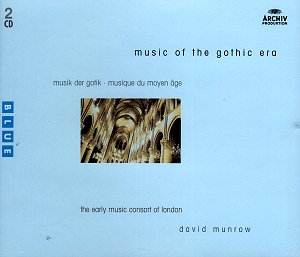To anybody interested in early music, and over the
age of about 25, the name of David Munrow will loom large as a formative
influence in any listening development. In a career spanning only ten
years, Munrow lit the firmament of early music like a comet. From 1966
until his death in 1976 he was a force that almost single-handedly brought
medieval and renaissance music out of the closet of musicology and onto
the mainstream concert circuit. The energy of the man was, by all accounts,
incredible, and it is a testament to that very energy that his recorded
legacy is so vast. This spans not only the dozen or so recordings (most
of which were large collections of multiple LPs covering, in depth,
specific repertoires, eras or genres), but also a book on medieval and
renaissance instruments. Then again there were hundreds of live concerts.
Probably even more influential were over five hundred editions of BBC
Radio 3’s "Pied Piper" in which this entirely self-taught phenomenon
researched, wrote and presented programmes on a bewildering range of
musical topics, by no means restricted to early music.
It is over twenty-five years since Munrow's death and
yet only in recent years have the recordings begun to be re-issued on
CD. Many of them are still not available. Thus, this re-issue on Archiv's
new "Blue" label is all the more welcome for this was Munrow's last
major recording project and has long been considered as probably his
finest achievement in the studio. In 1976, when this recording was first
released, medieval music was by no means unknown, but then neither was
it standard concert repertoire. It was still likely to be viewed as
an engaging eccentricity. It is remarkable that these discs still sound
so fresh and lively, even in the light of a quarter century of advance
in our understanding of the performance traditions surrounding this
repertoire. Obviously, Munrow was approaching this music from the perspective
of an instrumentalist, and the use of instruments in these performance
is somewhat more prominent than is fashionable today. Indeed, it must
be admitted that Munrow's preference for the doubling of vocal lines
with bells gets overdone at times. However, the instruments do give
a wide range of colours to the music that, even if not so historically
"correct" as we tend to be now, make, nonetheless, for a varied aural
diet and certainly add to the variety of the programme.
The booklet that accompanies this re-issue does not
include much in the way of information about the works recorded, but
it does include an illuminating essay by Daniel Leech-Wilkinson about
the way in which Munrow went about conceiving and bringing to fruition
this type of project. Leech-Wilkinson's most perspicacious point, and
one that defines the reason for the enormous success of this recording,
is that Munrow had an uncanny gift for finding and engaging great singers.
It was this feature more than any other that made the Early Music Consort
of London such a cut above the norm for its time. Indeed, looking at
the list of singers we see what amounts to a roll-call of the major
names of the current English early music scene. These singers were all
capable of performing this repertoire with the technical assurance that
makes the difference between the "amusingly eccentric" and
the "perspective-altering" reception of a performance. Indeed,
it is interesting to notice that amongst the singers are David James,
John Potter and Rogers (curiously always mis-spelt as Roger) Covey-Crump,
three of the four singers of the Hilliard Ensemble who were to become
the most obvious successors to Munrow’s group in this sort of repertoire.
With the Hilliard Ensemble these three recorded the great Pérotin
four-voiced organa (Viderunt omnes and Sederunt principes)
in the late 1980s for ECM. It is remarkable how much of the quality
of the performance recorded on this disc is still apparent in the Hilliard’s
later recording. It is these two organa of Pérotin that stood
out when the collection was released, and they are still the high-point
today. These mighty four-part works were already famous, but this performance
laid bare the inner architecture of Pérotin’s music in a way
that had not been attempted before. It was only the quality of the singers,
both technically and interpretatively, that allowed this to be the case.
These are ‘defining’ performances.
There are many other things of great beauty in this
collection. The seven instrumental Hocketts that open CD 2 are notable,
as is the wonderful performance of Machaut’s four-voiced motet Christe,
qui lux es, with slide trumpet and tenor shawm as well as two voices.
It would have been easy for a collection like this to centre on the
well known names of Léonin, Pérotin and Machaut, and yet
Munrow’s conception was more all-encompassing than that. Certainly Philippe
de Vitry and Adam de la Halle are names known to most people with any
scholarly interest in this period, and yet Bernard de Cluny and Petrus
de Cruce would probably, even today, be regarded as obscure, at best.
In attempting to give a complete overview of the chosen period Munrow
allied a scholarly approach of great depth and detail to a manner of
interpretation and performance that would allow the music to live in
its contemporary time. That the recording allows the music to live again
in our time is a sure testament to the quality and rigour of Munrow’s
approach. This collection remains a fascinating document both as a recreation
of early music in wonderful performances, and as a reminder of that
most exciting period of early music re-discovery in the mid-1970s. Without
a doubt, this collection deserves a place in the library of anybody
who claims an interest in early music.
Peter Wells





